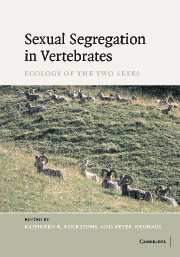Book contents
- Frontmatter
- Contents
- List of contributors
- Preface
- Part I Overview
- Part II Concepts and methodology
- Part III Foraging ecology
- Part IV Predator avoidance and reproductive strategies
- Part V Sex-related activities and social factors
- 10 Activity asynchrony and social segregation
- 11 Sexual segregation in ungulates: from individual mechanisms to collective patterns
- 12 Sexual segregation in humans
- Part VI Sexual differences in ecology: comparisons within different taxa
- Part VII Implications for conservation
- Part VIII Outlook
- References
- Index
12 - Sexual segregation in humans
Published online by Cambridge University Press: 04 September 2009
- Frontmatter
- Contents
- List of contributors
- Preface
- Part I Overview
- Part II Concepts and methodology
- Part III Foraging ecology
- Part IV Predator avoidance and reproductive strategies
- Part V Sex-related activities and social factors
- 10 Activity asynchrony and social segregation
- 11 Sexual segregation in ungulates: from individual mechanisms to collective patterns
- 12 Sexual segregation in humans
- Part VI Sexual differences in ecology: comparisons within different taxa
- Part VII Implications for conservation
- Part VIII Outlook
- References
- Index
Summary
OVERVIEW
As the chapters in this volume suggest, sexual segregation appears to be an important component in the social organization of many species. Indeed, some of the arguments made for sexual segregation among human children are similar to those made for sexual segregation in adults of other mammalian species (Ruckstuhl, 1998; Ruckstuhl & Neuhaus, 2002). For example, some authors suggest that male and female humans (Maccoby, 1998) and adult ungulates (Bon & Campan, 1996) segregate due to differences in behavioural ‘styles’. From this view, males interact with each other because their behaviour is physically vigorous and rough. Females, being more sedentary, avoid this sort of behaviour.
In this chapter we examine two hypotheses (‘energetics’ and social roles) proffered to explain the existence of social sexual segregation in human juveniles. This involves documenting what has been labelled ‘energetics’ (e.g. Ruckstuhl, 1998) or physical activity (e.g. Maccoby, 1998; Pellegrini et al., 1998), of the behaviours and social roles in male and female juveniles in humans. We will argue that segregation is based, ultimately, on male and female reproductive roles and can elegantly be explained by sexual selection theory (Darwin, 1871). As in most animals, human males experience more reproduction variation, relative to females (Trivers, 1971). This leads to males being the larger, more active and more competitive sex because they must compete with each other for access to mates. The social roles enacted correspond to reproductive roles and there are corresponding differences in levels of physical activity.
- Type
- Chapter
- Information
- Sexual Segregation in Vertebrates , pp. 200 - 218Publisher: Cambridge University PressPrint publication year: 2006

